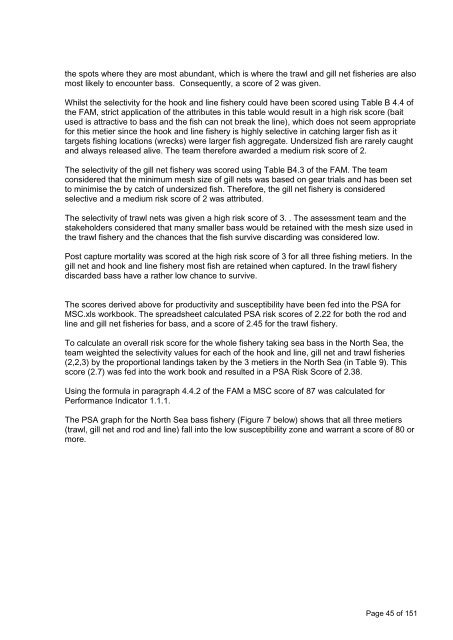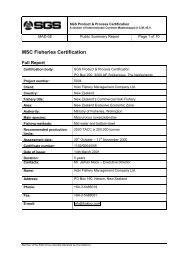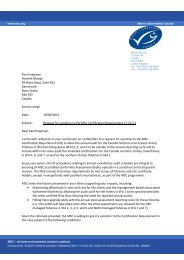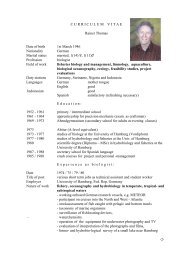SGS Product & Process Certification - Marine Stewardship Council
SGS Product & Process Certification - Marine Stewardship Council
SGS Product & Process Certification - Marine Stewardship Council
You also want an ePaper? Increase the reach of your titles
YUMPU automatically turns print PDFs into web optimized ePapers that Google loves.
the spots where they are most abundant, which is where the trawl and gill net fisheries are also<br />
most likely to encounter bass. Consequently, a score of 2 was given.<br />
Whilst the selectivity for the hook and line fishery could have been scored using Table B 4.4 of<br />
the FAM, strict application of the attributes in this table would result in a high risk score (bait<br />
used is attractive to bass and the fish can not break the line), which does not seem appropriate<br />
for this metier since the hook and line fishery is highly selective in catching larger fish as it<br />
targets fishing locations (wrecks) were larger fish aggregate. Undersized fish are rarely caught<br />
and always released alive. The team therefore awarded a medium risk score of 2.<br />
The selectivity of the gill net fishery was scored using Table B4.3 of the FAM. The team<br />
considered that the minimum mesh size of gill nets was based on gear trials and has been set<br />
to minimise the by catch of undersized fish. Therefore, the gill net fishery is considered<br />
selective and a medium risk score of 2 was attributed.<br />
The selectivity of trawl nets was given a high risk score of 3. . The assessment team and the<br />
stakeholders considered that many smaller bass would be retained with the mesh size used in<br />
the trawl fishery and the chances that the fish survive discarding was considered low.<br />
Post capture mortality was scored at the high risk score of 3 for all three fishing metiers. In the<br />
gill net and hook and line fishery most fish are retained when captured. In the trawl fishery<br />
discarded bass have a rather low chance to survive.<br />
The scores derived above for productivity and susceptibility have been fed into the PSA for<br />
MSC.xls workbook. The spreadsheet calculated PSA risk scores of 2.22 for both the rod and<br />
line and gill net fisheries for bass, and a score of 2.45 for the trawl fishery.<br />
To calculate an overall risk score for the whole fishery taking sea bass in the North Sea, the<br />
team weighted the selectivity values for each of the hook and line, gill net and trawl fisheries<br />
(2,2,3) by the proportional landings taken by the 3 metiers in the North Sea (in Table 9). This<br />
score (2.7) was fed into the work book and resulted in a PSA Risk Score of 2.38.<br />
Using the formula in paragraph 4.4.2 of the FAM a MSC score of 87 was calculated for<br />
Performance Indicator 1.1.1.<br />
The PSA graph for the North Sea bass fishery (Figure 7 below) shows that all three metiers<br />
(trawl, gill net and rod and line) fall into the low susceptibility zone and warrant a score of 80 or<br />
more.<br />
Page 45 of 151





